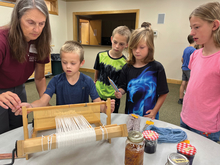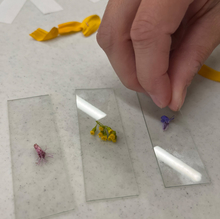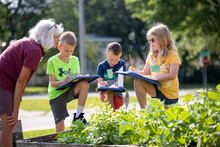Volunteers lead lessons on infusing fibers with plant dyes and journaling scientific observations
The children’s garden at Northland Arboretum in Crow Wing County is overflowing with a rainbow of vegetables — red cabbage, scarlet okra, brown-skinned onions. The preteens and young teens who tend it are learning where food comes from and how delicious fresh produce can be.
But that’s not the only reason for this beautiful bounty. They’re growing the garden under the guidance of Master Gardener Sally Jacobsen. And Jacobsen not only eats vegetables, she also uses them to produce dyes for textile arts.
“It’s a nice creative outlet,” she says. “It’s more of, ‘I want to try this and see if it works’ as opposed to “I think I’ll make a masterpiece, or I’m going to go into business doing it.’”
Fun with fiber
Jacobsen became interested in fiber arts more than three decades ago when she took a class at a weaver’s guild. That took a back seat when her kids came along. Then, a few years ago, she started combining weaving with another passion — gardening — by experimenting with making dyes from plants. The wild grapes in her back yard became the basis for purple fibers she could weave into her projects. Black walnut husks produced a rich brown color.
“A lot of it is experimenting,” she says. “I tried dandelions but didn’t like the way it turned out, so I threw it away.”
Jacobsen become a University of Minnesota Extension Master Gardener volunteer in 2020, following in the footsteps of siblings Bill Turcotte and Jackie Burkey. With COVID restrictions lifting, she was finally able this past summer to lead a children’s gardening program at the arboretum. Just over a dozen children joined her weekly throughout the growing season to dig a garden plot, plant seeds, pull weeds and harvest vegetables.
“It’s giving the kids the basics of gardening, and the gardens produce a lot of good produce,” she says. Along with the children’s favorites — kale and broccoli, believe it or not — the plots overflowed with lemon cucumbers, bok choy, purple peas, mouse melons and more. Some of these became the basis for art projects as well as lunch. Jacobsen showed her garden gang how they could capture the colors of summer by infusing them into natural fibers, such as wool and cotton.
In addition to using plants they grew in their own garden to dye yarn, she took the kids on walks through the arboretum to gather phlox, goldenrod, coneflowers and other colorful blooms to experiment with. She also introduced them to flower pounding — placing bright blossoms in between two pieces of muslin and then hammering on them to transfer the colors to the fabric.
Northland Arboretum executive director Candice Zimmermann can’t say enough about the value of Jacobsen and Extension’s many other Master Gardener volunteers who help beautify the arboretum and share the love of plants with others. “It’s such a great collaboration,” she says. “They’re our allies. They’re really making this place something beautiful.”
Gardening with pencils
Growing up with a soil conservationist father and a mother who gardened and canned, Jane Barton has always appreciated the value of connecting with sunshine, soil and plants. Having taught young children for decades as an elementary school teacher, she knows that children learn in many ways. So when the second- and third-graders she works with today as Master Gardener volunteer in the Children’s Garden in Residence program are done digging, she hands each a book made from notebook paper, along with colored pencils, and encourages them to reflect on the experience.
“Some children are very reluctant to express themselves in written form but are much more successful doing that with drawings,” Barton says. One student rapidly scribbles words, another draws a bright yellow sun shining down on the plants, and a third puzzles out the mysteries of pole bean growth with a diagram that looks like tinker-toy segments reaching toward the sky.
“We do what scientists do: observe, write, jot down notes, wonder and hypothesize what we think is going to happen next,” Barton says.
Barton and her Olmsted County team of Master Gardener volunteers mentor students in after-school and summer child care programs at Sunset Terrace Elementary School in Rochester. When they leave the program, they take their journals with them, along with encouragement to continue gardening and journaling about the experience.
“When you see it and write it down, it’s all very reinforcing to comprehension,” Barton says. “It really secures whatever new concept it is that you’re trying to learn.”






